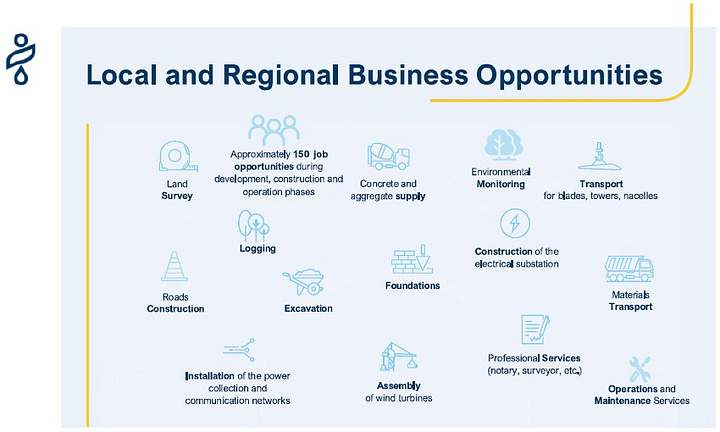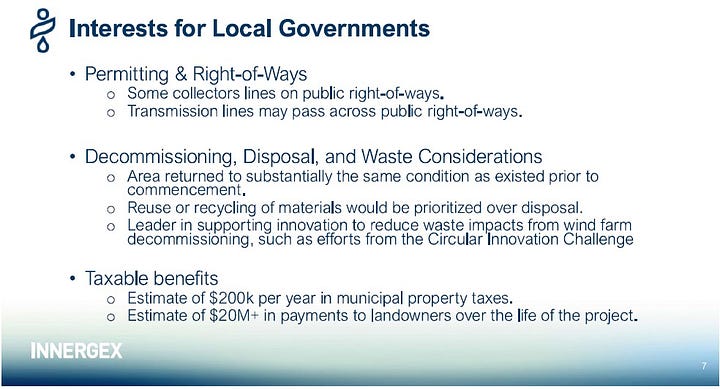For the second time in as many months, the Peace River Regional District board told Innergex Renewable Energy that the company needs to communicate better with the public about all their proposed projects.
Innergex was back at the PRRD board meeting on July 17 to discuss another potential wind farm project for the region. The company last gave a presentation to the board in May, when the directors passed on their constituents’ concerns about the company’s landmen approaching landowners in the Farmington and Bessborough areas, wanting to set up leases for a future project. At the time, directors informed Innergex that communication with the public is vital, especially with projects of the size the company is proposing.
At last Thursday’s meeting, Innergex’s Senior Development Manager Mike Goodman, and Development Associate Adeline Thames introduced the project that was causing landowners so much concern in the spring – the Bessie Wind project.
Goodman started off his presentation by stating that the Bessie Wind project is a separate project from the Stewart Wind which is to be located some 50 km northwest of where Innergex wants to build this latest project.
“We’ve been speaking to landowners, with First Nations, we really view this board and the people you represent as stakeholders, so we’re really happy to be here, to speak to it, and to try to be open and transparent, and let you know where we are in development,” Goodman said.
However, when asked by Area C director Brad Sperling if they have had or plan to have any community meetings, Goodman replied that they intend to have open houses and involve the community, but the timing for that would be better for when they have a layout and the project has been awarded.
“We intend to do that in early 2026, if this project is awarded through the BC Hydro RFP process.”
“I’ll give you some friendly advice,” Sperling said. “That area has gone through a lot of oil and gas, and a lot of community meetings. The companies waiting until projects were drawn out and everything have caused a lot of issues.”
He added: “If you’re out there talking to landowners, you should be talking to the community also.”
This shouldn’t be news to Innergex, whose representatives were told by regional district directors during their May presentation that they needed to be transparent with people.
Goodman says Innergex believes in working closely with communities and intends to do that with the Bessie Wind project.
“We’re speaking to landowners within this area,” he said. “We’ve had lots of great conversations and will continue to do so."
Board chair Leonard Hiebert echoed Sperling’s advice to Innergex representatives: “Specific to community meetings, the sooner you get out there the better it’s gonna be.”
The proposed Bessie Wind project is the third project in northeastern British Columbia that Innergex is involved in. Its other projects are Dokie Wind, west of Chetwynd and the recently government-approved Stewart Wind which is to be in the Groundbirch and Stewart Lake areas on Crown land.
Bessie Wind will be located within the Agricultural Land Reserve, geo-located within an area of approximately 200,000 acres, the perimeter will be about 100km on private land between Farmington and Dawson Creek. The footprint of the project will change as land agreements progress, explained Goodman.
The 25 to 45 turbines for the proposed project will be 125m at the hub height, with rotor blades approximately 80m in length, and the finished turbines will be about double the height of the BC Hydro infrastructure along the highway, Goodman said.
“It needs to be a certain size for BC Hydro’s call for energy, but we will look to kind of hone in on that in the next six or seven months.”
“These turbines are larger than Bear Mountain, but there’s a separation, at least 600m from dwellings, but likely it will be even further.”
Tumbler Ridge director Darryl Krakowka asked about the impact on neighbouring property owners, who might find they have a turbine 600m from their home.
Goodman replied that they recognize that there are visual and sound impacts, and that Innergex will adhere to the sound monitoring and sighting policies, which contain requirements for separation. The turbines will be about a kilometre apart on average, he said, but these distances are preliminary as they don’t have a layout of the project ready yet.
Thames added that throughout the negotiation process they’ll make sure that turbines won’t be placed a spot that’s “extremely inconvenient” for landowners and neighbours. “To make sure that everyone is hopefully as happy as possible.”
Innergex anticipates Bessie Wind will create between 150 to 200 jobs from construction through to operations, including logging, road construction, electrical substation construction, wind turbine assembly, land surveying and environmental monitoring.


“If we are successful in being awarded the project, we would pursue a local procurement policy and work closely with the regional board and other local groups to best understand where we could find the best folks for the job,” Thames said.
She also acknowledged that decommissioning, disposal and waste considerations are “hot topic items for wind projects and renewables in general.”
“We make a commitment in our leases and the permitting process to return the area to the same condition prior to commencement or to restore as much as possible to offset any disturbance that cannot be returned to its prior state,” she said.
Thames said Innergex also intends to recycle materials as much as possible, as recycling is an ongoing topic in the field as wind energy is becoming more prevalent.
“Innergex is currently supporting the Circular Innovation Challenge, which is working to identify different innovative solutions to repurpose the non-recyclable elements of wind turbines.”
The towers, for example, are made largely of aluminum, steel and copper which are highly recyclable, but the blades are made of fiberglass which is harder to recycle. Some of the options for recycling including looking at repurposing the blades into lower-carbon cement, or by using them as infrastructure for bus stops.
Krakowka posed another question that crops up at every presentation from a wind farm proponent, “what they do with the blades when they need replacing, today?”
Thames replied that the Dokie Wind Farm has only had to do one blade replacement in 15 years of operation. Half of the blade was donated to Northern Lights College for use in their Wind Technician Training Program, while the other half went to the landfill. Thames considered it fortunate that it was only one blade, “we’re hoping to have better options for that reuse and recycling by the time a windfarm such as this would get to end of life.”
“Being a part of this energy sector group that is really looking at using wind energy from the North, it really is getting to be a much larger conversation. There are more and more popping up every year, and the conversation just keeps being the same – we’ll figure it out in 50 years and that’s becoming more concerning to me, as everyone keeps giving me the same spiel,” said Pouce Coupe director Danielle Veach.
“The fact that to date, the blades that are being replaced, half of them are still ending up in the landfill is not great, especially with how many we have popping up throughout our region. I urge you to stop going from an idea, to begin coming forward with a plan, because I think eventually people are going to start demanding an actual plan. That is something I find extremely concerning, not only as an elected official, but as somebody who lives here.”
“This is something that does need to be figured out, and not in 50 years.”
The deadline for proposing the project, and answering the Request for Proposal is early December 2025, Goodman told the board. They will know in early 2026 if the RFP has been awarded, and from there Innergex will engage in a four-year process of moving through studies, design, permitting and engagement, before the two-year construction period would begin.
“We intend to engage from the get-go, all the way through the project life,” he said.






